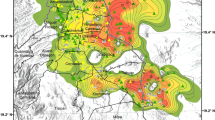Abstract
On Monday, May 12, 2008, a devastating mega-earthquake of magnitude 8.0 struck the Wenchuan area, northwestern Sichuan Province, China. The focal mechanism of the earthquake was successive massive rock fracturing 15 km in depth at Yingxiu. Seismic analysis confirms that the major shock occurred on the Beichuan–Yingxiu Fault and that aftershocks rapidly extended in a straight northeast–southeast direction along the Longmenshan Fault zone. Fatalities approaching a total of 15,000 occurred, with a significant number resulting from four types of seismically triggered geohazards—rock avalanches and landslides, landslide-dammed lakes (“earthquake lakes”), and debris flows. China Geological Survey has identified 4,970 potentially risky sites, 1,701 landslides, 1,844 rock avalanches, 515 debris flows, and 1,093 unstable slopes. Rock avalanches and landslides caused many fatalities directly and disrupted the transportation system, extensively disrupting rescue efforts and thereby causing additional fatalities. Landslide-dammed lakes not only flooded human habitats in upstream areas but also posed threats to potentially inundated downstream areas with large populations. Debris flows become the most remarkable geohazards featured by increasing number, high frequency, and low triggering rainfall. Earthquake-triggered geohazards sequentially induced and transformed to additional hazards. For example, debris flows occurred on rock avalanches and landslides, followed by landslide-dammed lakes, and then by additional debris flows and breakouts of the landslide-dammed lakes and downstream flooding. Earthquake-induced geohazards occurred mainly along the fault zone and decreased sharply with distance from the fault. It can be anticipated that post-earthquake geohazards, particularly for debris flows, will continue for 5–10 years and even for as long as 20 years. An integrated strategy of continuing emergency response and economic reconstruction is required. The lesson from Wenchuan Earthquake is that the resulted geohazards may appear in large number in active fault regions. A plan for geohazard prevention in the earthquake-active mountainous areas is needed in advance.










Similar content being viewed by others
References
Burchfiel BC, Chen Z et al (1995) Tectonics of the Longmen Shan and adjacent regions, central China. Int Geol Rev 37(8):661–735
Costa JE (1985) Flood from dam failures: flood geomorphology. In: Baker VR, Kochel RC, Patton PC (eds) US Geological Survey Open-File Report, vol 54
Costa JE, Schuster RL (1991) Documented historical landslide dams from around the world. U.S. Geological Survey, pp 91-239
Cui P, Liu SQ et al (2003) Debris flow prevention pattern in national parks: taking the world natural heritage Jiuzhaigou as an example. Sci China Ser E 46(Suppl):1–11
Cui P, Wei FQ, He SM et al (2008) Mountain disasters induced by the earthquake of May 12 in Wenchuan and the disaster mitigation. J Mt Sci 26(3):280–282 (in Chinese)
Densmore AL, Ellis MA, et al (2007) Active tectonics of the Beichuan and Pengguan faults at the eastern margin of the Tibetan Plateau. Tectonics 26(TC4005). doi:10.1029/2006TC001987
Kallen D, Xiang W et al (2006) Landslides at Qingjiang river in the downstream area of Shuibuya dam site, China. J China Univ Geosci 17(2):158–162
Lin LF, Fang C, Li XJ et al (2008) Analysis on geohazards in 512 Wenchuan earthquake hit area. Hydrogeol Eng Geol 2008(4):129–132 (in Chinese)
Meade BJ (2007) Present-day kinematics at the India-Asia collision zone. Geology 35(1):81–84
Tian LQ (1986) Debris flow in the Luhe earthquake area, Sichuan Province. Debris flow (3), Chongqing Branch of Science and Technology Literature Press, Chongqing, pp 58–66 (in Chinese)
Yin YP (2008) Researches on the geo-hazards triggered by Wenchuan earthquake, Sichuan. J Eng Geol 16(4):433–444 (in Chinese)
Acknowledgments
This research was supported by State Key fundamental Research Program (973) project (2008CB425802) The authors acknowledge the contributions of Si-ming He, Yong You, Zhan-lu Li, Cao Dang, and Chen-lin Yang, who were involved in the field investigations, and several postgraduate students, who did some of the geohazard mapping. We also thank Dr. Kevin Scott of USGS for his help in improving the English language.
Author information
Authors and Affiliations
Corresponding author
Rights and permissions
About this article
Cite this article
Cui, P., Chen, XQ., Zhu, YY. et al. The Wenchuan Earthquake (May 12, 2008), Sichuan Province, China, and resulting geohazards. Nat Hazards 56, 19–36 (2011). https://doi.org/10.1007/s11069-009-9392-1
Received:
Accepted:
Published:
Issue Date:
DOI: https://doi.org/10.1007/s11069-009-9392-1




